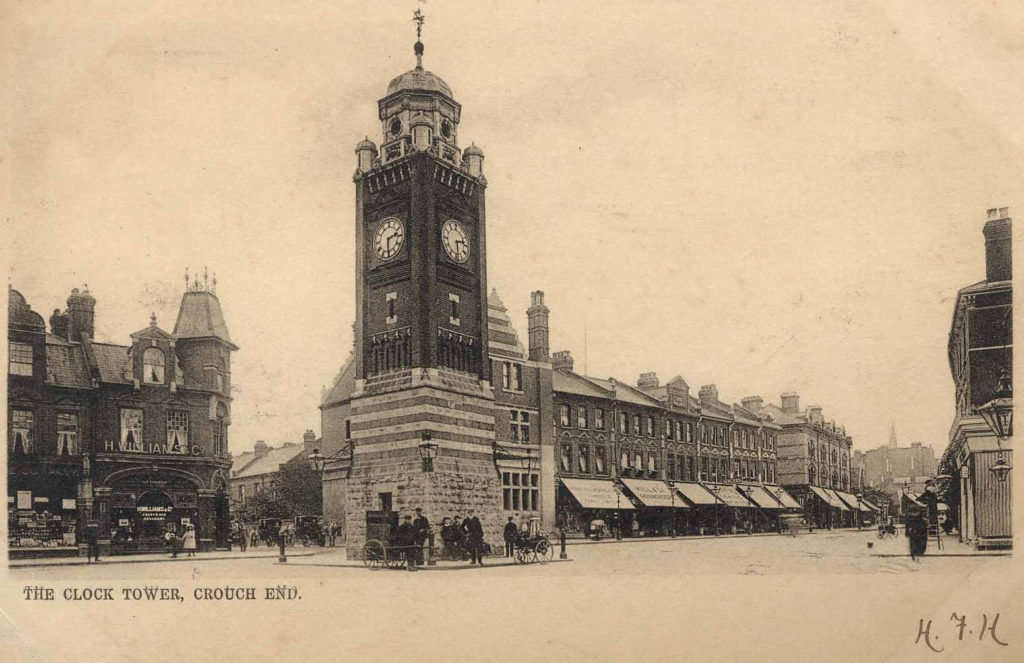The clock tower, a much loved if not exactly architecturally distinguished building, was erected in 1895 in ‘appreciation and recognition of the public services’ of Henry Reader Williams (1822-97). Bridget Cherry in the revised Pevsner (London 4: North) calls it a ‘jolly”

The local benefactor
Williams, an important local benefactor, whose achievements were certainly worthy of such commemoration, was Chairman of the local authority of Hornsey from 1880-1894, and played a key part in shaping the district, in particular campaigning against developers for the preservation of Highgate Wood and Queen’s Wood. He also paved the way for the purchase of Alexandra Palace and Park by a consortium of local authorities in 1901, after his death. His aim was to make Hornsey a model suburb.
Inauguration
Immediately after Williams’s retirement from his work for the local council, it was decided by the newly designated Hornsey Urban District Council to erect a clock tower to celebrate his achievements. After this things proceeded with a speed that would be unbelievable today. Out of the estimated cost of £1200, £900 was raised by public subscription in the first three weeks.
The tower was commissioned, designed and built in a matter of months, and on June 23rd, 1895 a ceremony held for its unveiling. The Broadway was hung with flags, and the Tower connected to nearby houses with festoons. A thousand or more people assembled, including the great and the good of Hornsey, speeches were made and at 12 noon the Earl of Stafford, Lord-Lieutenant of Middlesex, released a blue ribbon hanging from the belfry and the clock struck its first notes.
Design
The clock tower was designed by the architect Frederick Knight and built by a Highgate builder, J. W. Dixon. The most distinguished man to be involved with it was Alfred Gilbert, the sculptor of the portrait head of Williams done in bronze that fits in a circular niche on the south side of the tower. Gilbert had recently designed the monument for Earl of Shaftesbury in Piccadilly Circus, known to us as Eros.
The square tower, with what has been called its ‘friendly chunkiness’ (Joan Schwitzer), is typically late Victorian in its mimicking of Italian Renaissance style; eclectic in its use of building materials, it has a solid-looking base of rusticated Kentish ragstone blocks, a second level of horizontal buff-yellow and brick red bands of terracotta, a two-part storey of red brick with all sorts of fine detailing, including blind arcades and corbels, into which the four faces of the clock are set, and at the top an octagonal cupola of cream terracotta, with corner turrets, surmounted by an iron weathervane. It measures [63 feet] from the ground.
Role in history
The tower is sited at the heart of Crouch End, at the point where the Broadway splits into Park Road and Tottenham Lane, and once a wooden cross stood, perhaps the origin of Crouch End’s name (‘crux’ is Latin for ‘cross’).
Its construction came at a time when Hornsey and especially Crouch End were flourishing; Crouch End was well into its transition from rural village to prosperous suburb, with large and well built new houses and wide tree lined roads which Williams himself had been instrumental in ensuring. Crouch End Broadway was soon to become a major shopping centre, and the clock tower, at its northern end was the area’s most prominent landmark.
While its role now is mainly ornamental, a grade II listed building on a traffic island, it has been functional in the past in several ways. Originally, it was the terminus for the horse-drawn omnibuses which operated between Crouch End the Shaftesbury Tavern on the Stroud Green Road. The drinking fountain, with its smooth granite bowl, inset into the south face of the ground floor level was used by both horses and human beings, important at a time when clean drinking water was not so easy to come by. The significance of the tower as a focal point for the local community is evident from the fact that on November 11th, 1918 a fiddler played at its foot to signal the armistice.
A public convenience
In 1936 public conveniences were constructed in the basement; locals objected to the fact that, as decided by the council, they were styled ‘Women’ and ‘Men’ rather than ‘Ladies’ and ‘Gentlemen’. They ceased to operate in the 1990s and the drinking fountain no longer works. Nowadays the clock tower is a meeting place, a site where people can gather to distribute leaflets, play instruments, or sing carols, or simply hang about and chat while the traffic swirls around.
On its centenary in June 1995 a crowd gathered to celebrate, and the Crouch End Festival Chorus sang Jerusalem and Happy Birthday. A commemorative poster was produced. Every Christmas it is garbed in a skirt of lights. As local estate agents recognise in their promotional material, the clock tower is an iconic building, quaint, characterful, signifying something of the particular charm of Crouch End.
Further Reading:
Eric Robinson, ‘Geology in a Clock Tower’, Bulletin of the Hornsey Historical Society 42 (2001)
Joan Schwitzer, Crouch End Clock Tower (1995, 2002)
Ben Travers, The Book of Crouch End (1990)
Hornsey Journal, issues 8, 22, 29 June, 1895